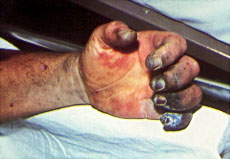SEPTICAEMIC PLAGUE
Septicaemic plague is a progressive, powerful bacterial infection.Septicaemic plague develops in the absence of apparent regional buboes, and the diagnosis of Plague is often not suspected until preliminary blood culture results are positive by the laboratory. Yersinia pestis is also in the blood of most bubonic plague patients but in septicaemic plague the patient is desperately ill and requires urgent care.
Patients with septicaemic plague often present gastrointestinal symptoms of nausea, vomiting, diarrhoea, and abdominal pain.
If not treated early with appropriate antibiotics, septicaemic plague can be fulminant and fatal. The steps of the infection are as follows:
Petechiae (red spots in the skin), bleeding from puncture wounds and orifices, and gangrene of fingers and toes are manifestations of septicaemic infection. Adult respiratory distress syndrome occurs at any stage of septicaemic plague, and is sometimes confused with other diseases. Then appear hypotension, renal infection, and other signs of shock. Those are preterminal events and death is next.
